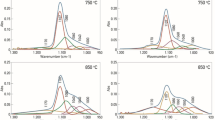Abstract
Oxygen donor traps and oxygen-related precipitates are investigated by deep level transient spectroscopy (DLTS) and transmission electron microscopy (TEM). The so-called New Donors (ND's) occur after thermal treatments in the temperature range of 650 °–800 ° C. They have a continuous distribution of trap states with respect to energy in the band gap of Si. The concentration of the trap states increases towards the conduction band edge. The precipitates observed are mainly platelets and ribbon-like defects. The formation and annihilation kinetics of ND traps and oxygen-related precipitates are correlated. An “SiO x Interface Model” is proposed to explain the origin and the donor-like behavior of the ND traps. The ND trap spectrum is composed of two different types of trap states: interface states at the surface of precipitates and bound states in the Coulombic wells of a fixed positive charge which is located in the SiO x precipitates.
Similar content being viewed by others
References
W. Zulehner, D. Huber: InCrystals Vol. 8 (Springer, Berlin, Heidelberg 1982) p. 1
J.H. Matlock: Silicon Processing, ASTM STP 804, ed. by D.C. Gupta (American Society for Testing and Materials 1983) p. 332
L. Jastrzebski, R. Soydan, J. McGinn, R. Kleppinger, M. Blumenfeld, G. Gillespie, N. Arnold, B. Goldsmith, W. Henry, S. Vecumbra: J. Electrochem. Soc.134, 1018 (1987)
K. Hölzlein, G. Pensl, M. Schulz, P. Stolz: Rev. Sci. Instrum.57, 1373 (1986)
J. Patel, W. Jackson, H. Reiss: J. Appl. Phys.48, 5279 (1977)
P. Freeland, K. Jackson, C. Lowe, J. Patel: Appl. Phys. Lett.30, 31 (1977)
W. Patrick, E. Hearn, W. Westrop, A. Bohg: J. Appl. Phys.50, 7156 (1979)
J.R. Patel:Semiconductor Silicon 1981, ed. by H.R. Huff, R.J. Kriegler, Y. Takeishi, Electrochem. Soc. Pennington, N.J. 1981, p. 189
K. Tempelhoff, B. Hahn, R. Gleichmann: In Ref. [8], p. 244
K. Wada, H. Nakanishi, T. Takaoko, N. Inoue: J. Cryst. Growth57, 535 (1982)
J. Desseaux-Thibault, A. Bourret, J.M. Penisson: Inst. Phys. Conf. Ser.67, 71 (1983)
H. Bender: Phys. Status Solidi (a)86, 245 (1984)
A. Bourret, J. Thibault-Desseaux, D.N. Seidman: J. Appl. Phys.55, 825 (1984)
A. Bourret: Inst. Phys. Conf. Ser.87, 39 (1987)
W.A. Tiller: J. Appl. Phys.59, 3255 (1986)
G.F. Cerofolini, L. Meda, M.L. Polignano, G. Ottaviani, H. Bender, C. Claeys, A. Armigliato, S. Somi:Semiconductor Silicon 1986, Proc. 5th Int. Symp. on Silicon Materials Science and Technology, ed. by H.R. Huff, T. Abe, B. Kolbesen (The Electrochem. Soc., Pennington N.J. 1986) p. 706
W. Bergholz, J.L. Hutchison, P. Pirouz: J. Appl. Phys.58, 3419 (1985)
W. Bergholz, J.L. Hutchison, P. Pirouz: Proc. Oxford Conf. on Micr. of Semicond. Mater., 1985
W. Bergholz, J.L. Hutchison, G.R. Booker: In Ref. [16] p. 874
P. Capper, A.W. Jones, E.J. Wallhouse, J.G. Wilkes: J. Appl. Phys.48, 1646 (1977)
A. Kanamori, M. Kanamori: J. Appl. Phys.50, 8095 (1979)
V. Cazcarra, P. Zunino: J. Appl. Phys.51, 4206 (1980)
K. Schmalz, P. Gaworzewski: Phys. Stat. Solidi (a)64, 151 (1981)
P. Gaworzewski, K. Schmalz: Phys. Stat. Solidi (a)77, 571 (1983)
N. Fukuoka: Jpn. J. Appl. Phys.24, 1450 (1985)
K. Yasutake, M. Umeno, H. Kawabe, H. Nakayama, T. Nishino, Y. Hamakawa: Jpn. J. Appl. Phys.21, 28 (1982)
M. Tajima, U. Gösele, J. Weber, R. Sauer: Appl. Phys. Lett.43, 270 (1983)
P. Wagner, C. Holm, E. Sirtl, R. Oeder, W. Zulehner: InAdvances in Solid State Physics, XXIV, ed. by P. Grosse, (Vieweg, Braunschweig 1984) p. 191
K. Hölzlein, G. Pensl, M. Schulz: Appl. Phys. A34, 155 (1984)
K. Hölzlein: Ph. D. thesis, University of Erlangen 1985
K. Hölzlein, G. Pensl, M. Schulz, N.M. Johnson: Appl. Phys. Lett.48, 916 (1986)
K. Hölzlein, G. Pensl, M. Schulz, N.M. Johnson: Mat. Res. Soc. Symp. Proc.59, 481 (1986)
A. Henry, J.L. Pautrat, K. Saminadayar: InMaterial Science Forum,10–12, ed. by H.J. von Bardeleben (Trans. Tech. Publications Ltd., Switzerland 1986) p. 985
M. Schulz: Surf. Sci.132, 422 (1983)
J. Frenkel: Phys. Rev.54, 647 (1938)
H. Lefevre: Appl. Phys. A22, 15 (1980)
R. Wörner, O.F. Schirmer: Phys. Rev. B34, 1381 (1986)



